On any given day, depending on the circumstances, a dog might have a multitude of opportunities to meet and greet a number of other creatures: dogs, cats, horses, a variety of other species, and all sorts of humans. Some dogs seem to do it with aplomb, while others are clearly overexcited and unable to contain themselves. I suspect most if not all of us would far rather have the dog who’s calm, cool, and collected rather than the other option. So how do we get there?
Undermining Your Dog’s Success in Greeting
When our dog jumps on someone, we all tend to roll our eyes and apologize. A well-behaved dog shouldn’t do this! Why is learning to greet people without jumping on them such a challenge for so many of our dogs?
The answer is intermittent reinforcement – which means that the behavior is sometimes reinforced. “But wait!” you say. “I don’t reward my dog for jumping on people!” Perhaps not. But perhaps you aren’t aware of all the other times or ways your dog is being reinforced for the behavior. Every time your dog jumps on someone and they say, “Oh, it’s okay, I don’t mind!” and then pet and fuss over her, your dog is being reinforced for jumping up.
It’s also likely to be reinforcing for your dog every time she jumps on someone and he physically pushes her away – “Yay, he touched me!”
Intermittent reinforcement makes a behavior more resistant to extinction – harder to stop. It is the same force at work when a human finds it difficult to stop playing a slot machine; as long as you get rewarded occasionally (enough so that you don’t run out of money!), you may just keep playing and playing. Similarly, your dog may just keep playing the jump-up game, thinking, “Eventually I will win. Maybe this time it will pay off and I will get petted… Jackpot!!”
I’m going to describe three important elements to successfully teaching your dog to greet humans politely; the first and most important one is aimed at putting an end to that intermittent reinforcement.
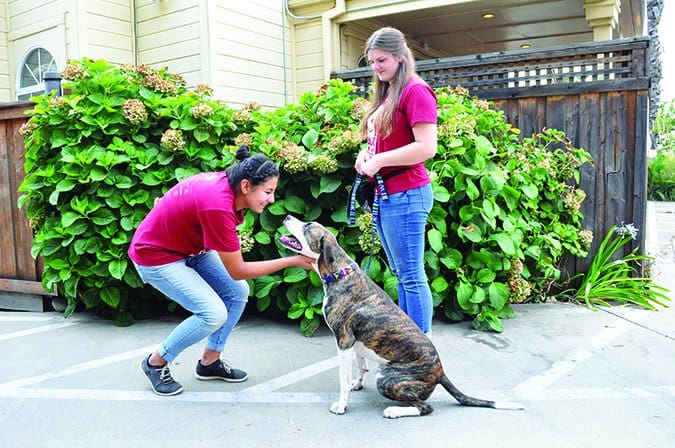
Best Place to Start: Basic Good Manners Training Classes
Most things in life with our dogs are easier if they’ve had some basic good manners training. A well-run force-free group class is my first choice for working on this; it gives your dog the opportunity to generalize her good manners to new environments and distractions, especially other dogs and humans. Your class instructor and assistants will also be able to give you feedback on your own skills – something you miss if you do all your training on your own.
A common goal for basic good manners training is for your dog to learn that her highly reinforced “sit” is a good “default” behavior (the best behavior to offer when she’s not sure what to do), which comes in very handy when teaching polite greetings. In addition, most good manners classes formally teach polite greetings to humans and provide coaching on how to help your dog behave appropriately in close proximity to other dogs.

3 Steps to Greeting Humans Politely
1. Manage the situation.
In this context, “management” means controlling your dog’s environment so she isn’t intermittently reinforced for jumping up. This mainly entails always keeping her on a leash when she greets people, and providing very clear, simple instructions to everyone who wants to greet her – family, guests, and random humans on the street – regarding how they should interact with her to reinforce polite greeting behavior.
Sometimes, this may mean sacrificing politeness for firmness when you encounter one of those “Oh, it’s okay!” dog lovers. Be ready to tell him no, it’s not okay, and you’d love to have him pet your dog if he will follow instructions. If he scoffs or gives you the sense that he’s going to do what he wants to do anyway, be prepared to say, “Whoops! Sorry!” and do a quick U-turn with your dog away from the would-be management underminer.
When visitors come to your home, consider using a tether to keep your dog away from the door, or park her behind a baby gate, so you can greet your guests without worrying about dog-jumping. Once the initial excitement of your guests’ arrival is over, it’s easier to instruct them on how to greet your dog properly.
Another alternative, if you want your guests to be interactive with your dog at the door, is to set them up to succeed with treats, toys, and a few basic instructions on how to use these to help your dog practice good greetings. This is a fun way to enlist the help of visitors to teach your dog to sit to greet people at the door.
Place a basket of toys by your door – toys your dog really likes. Tape a sign next to it instructing visitors: “Take a toy before you come in. When Bouncy runs up to you, hold the toy at your chest. When she sits, throw the toy for her to chase. If she brings it back, you can do it again.”
For a dog who doesn’t get excited about toys, you can use high-value non-perishable treats instead. (Real Meat Treats are my favorites for this; see realmeatpet.com.) Break the treats into small pieces in advance, hang a reusable, resealable bag of treats by the door, and tape up a sign that instructs your visitor to take a handful, wait for Bouncy to sit, and then fling some treats behind the dog.
Both of these methods reinforce Bouncy for sitting to greet your guests and directs her energy away from them as she chases after the toy or treats. Plus, it’s fun for your dog and your guests!
2. Reinforce her for sitting a lot – every chance you get!
In what I call a “Say Please Program,” your dog’s sit makes everything good happen. A sit makes her dinner arrive. A sit gets her leash clipped on and another one gets the door to open for your walk together. Sits also elicit a toy or a treat. This will help make sit her default behavior and increase the odds that she will offer a sit when she is approached by someone.
3. Practice polite greetings.
You can do this yourself by tethering your dog to a solid object and repeatedly approaching and feeding her a treat when she sits. Have everyone in the family try it, too!
If she tries to jump up on you when she isn’t tethered, say “Oops!” in a cheerful tone of voice, turn your back and step away from her.
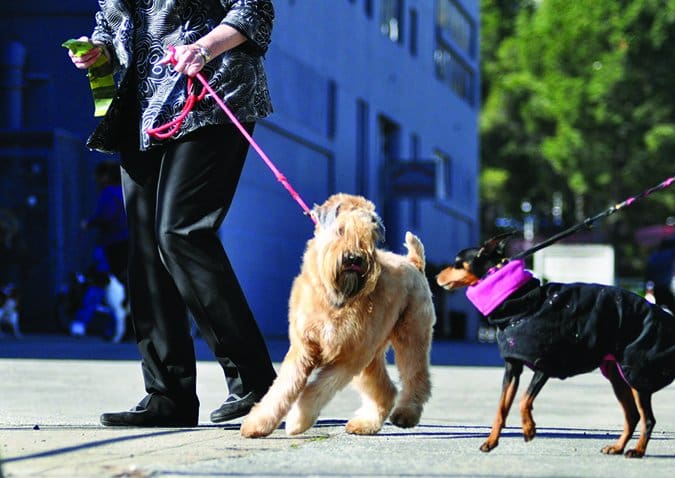
You can also practice this with friends or anyone else who would like to greet your dog. Hold your dog’s leash firmly, not allowing your dog to stretch your arm toward the greeter. As your acquaintance approaches, tell him not to interact with or give your dog a treat until she sits.
No Non-Consensual Dog-Dog Greetings
Just last week I was sitting with my new dog Sunny in our vet’s waiting room, and a man walked in with his 8-month-old, 120-pound Great Dane, who immediately began straining to come see my 16-pound dog. To my amazement and consternation, the man walked forward, allowing his dog to approach. I held up my hand and said firmly, “Please, no!”
“No? He likes little dogs,” the man responded. “He lives with a Pomeranian and they are best friends.”
“No,” I answered firmly, not bothering to add that my dog doesn’t live with a Great Dane and was showing signs of concern about the giant canine looming just six feet away.
The man took a seat on the other side of the small waiting room, and I did a little counter-conditioning with Sunny while both of us regained our equilibrium. Then I engaged in polite chat with the Dane’s owner, suggesting that lots of little dogs don’t like being approached by big dogs. He nodded, seeming to understand.
A few minutes later a woman walked in with a dog half of Sunny’s size, and the man again let his dog approach. The little dog was even more worried that Sunny had been, crying out, backpedaling on his leash, and trying to hide behind his human. This went on for many long seconds, until the woman finally picked up her dog and took a seat just out of reach of the Dane. Sigh…
Not only do dogs who are routinely allowed to greet other dogs on leash come to expect being allowed to do so, they can become quite frustrated and aroused when their desire to meet and greet is thwarted. There is a whole class of reactive dogs who are known as “frustrated greeters.” These are often the dogs who seem to play happily with other dogs when they are off-leash, but when the leash goes on they appear to turn into Cujo.
Guidelines for Greeting Other Dogs Safely
In order to avoid creating frustrated greeters, or worsening the behavior of the dogs who are already frustrated, my rule for dogs in my classes (and for my own dogs) is, “We don’t greet other dogs on leash. Period.” I see far too many dogs who are routinely allowed to greet other dogs on leash and whose behavior is very problematic. As soon as they see another dog they bark, scrabble, and pull, dragging their human toward the other dog until contact is accomplished, whether the other dog likes it or not.
Hence my solution: Allow dogs to greet and interact only in a safely enclosed area, where leashes can be dropped with a “go play” cue when it’s evident the dogs are compatible. Leashes stay on for the first few minutes of interaction, in case the dogs need to be separated, but are removed as soon as it’s clear that the dogs will play together well.
I do understand that this isn’t always possible. Dog owners who live in cities may find safely enclosed dog-play spaces hard to come by, not to mention compatible playmates accompanied by humans who are willing to arrange play dates. Sometimes, the only social options of urban dogs are on-leash greetings. If you are in the “really have to/want to” category, here are some suggestions to help you avoid future problems:
Teach your dog to approach other dogs on a loose leash.
(See “Loose Leash Walking: Training Your Dog Not to Pull“.) Pulling and straining on leash to reach another dog can send unsettling body language signals to the other dog, making the encounter less likely to be successful. It also increases arousal in your dog, again making the encounter less likely to be successful.
Teach a solid “Walk Away” behavior so you can easily interrupt an encounter that seems to be getting too intense.
Even if the intensity is playful. Pulling a dog away forcibly on leash can add tension that causes an otherwise successful encounter to go south. (See “How to Teach Your Dog to Just ‘Walk Away’“.)

Greet other dogs only occasionally.
Most of the time, your dog’s job when she is on leash is to be with you. Just as you give her permission to go sniff when it’s appropriate to do so, have a cue that gives her permission to greet another dog – and use it sparingly. Far more often than not, you want her to “not-greet.”
Use high-value treats and consistently reinforce your dog for paying attention to you in the presence of other dogs.
If we have our dogs’ attention, we can get them to work with us. If we can keep their attention, we can keep them working with us in the face of distractions. (See “It’s All In Your Dog’s Eyes“.)
Know what type of dog yours is likely to be comfortable with.
Even dogs who do well with other dogs don’t necessarily like to engage with all other dogs. Size, energy level, and play style are just three factors that may determine play-pal predilections. Some dogs have breed or size preferences; a bad experience with a particular type of dog in the past can give your dog a negative association with that type for life.
When you see a dog you would like yours to greet, ask permission from the other owner first, and respect their wishes. If they say no, it’s a no – don’t try to talk them into it. Conversely, be politely firm with your “No” if someone wants to approach yours with a dog you’re not comfortable with. Be your dog’s advocate.
Ready to Greet
Here is how to proceed when you are ready to do on-leash greetings, and you see a dog who fits the bill and whose owner has agreed to the encounter.
Start out by doing some parallel walking first, so the dogs get a little more information about each other prior to actually engaging – and you get a little more information about the dogs! Watch both dogs’ body language throughout the entire encounter and be prepared to abort if appropriate. (For more information about canine body language, see “Listening to Your Dog’s Body Signals“.)
If their body language tells you they are comfortable walking in proximity to each other, coordinate with the other owner and give the “go play” cue.
As the dogs engage, keep the leashes loose! This is so critically important it bears repeating: Keep the leashes loose! If there’s tension between the dogs as they greet, a tight leash greatly magnifies the tension and can cause what otherwise might have been a very successful greeting to fail. This usually take some fancy footwork on the part of the humans; as the dogs circle, sniff, play bow, and bounce you will need to circle with them and always be prepared to move forward to give extra leash slack as needed.
It’s a good idea to interrupt the encounter if play starts to get rowdy. You simply cannot manage leashes well enough if dogs are getting very excited. If the two look like they both want to be rough-and-tumble run-and-chase play buddies, you really do need to find that elusive “safely enclosed area” so they can play together to their hearts’ content.



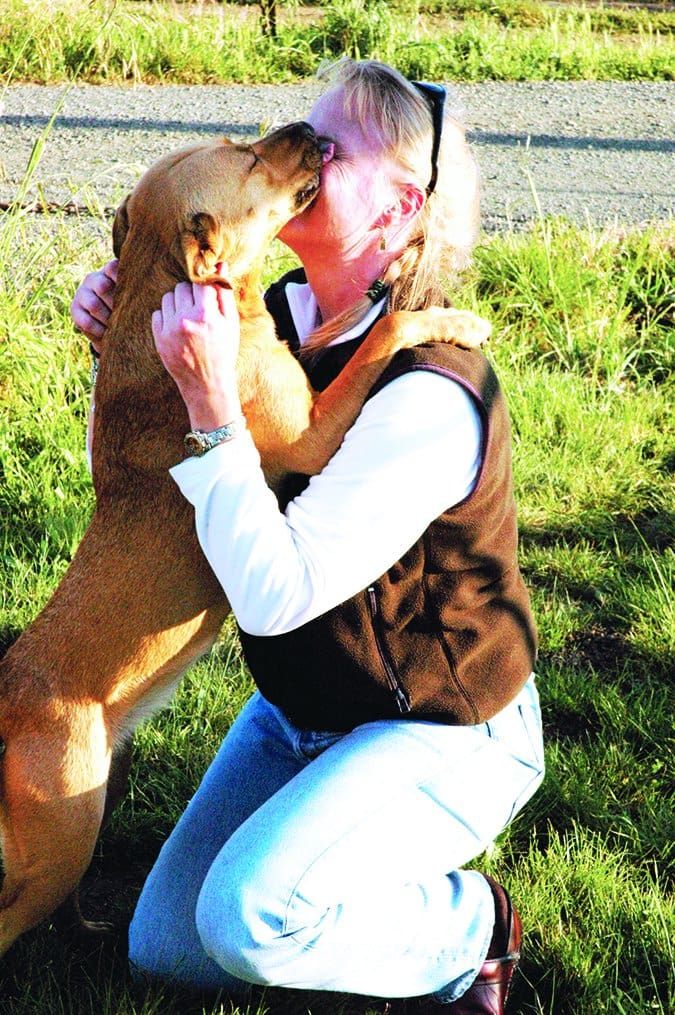
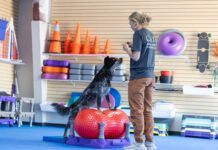
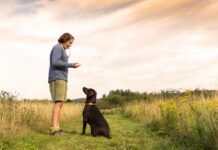

Hi, that was useful info; thanks. My 2 y.o. dog has recently started exhibiting aggressive behavior towards other neighborhood dogs who he used to meet cheerfully. For example, this morning, he went to say hello to another dog who he has crossed paths with many times before (but hasn’t seen in several months). They have always had playful interactions previously. It started off with a friendly sniff and happy wagging tails, but then suddenly, I heard a growl and felt a lunge as if he was trying to bite the other dog! 🙁
There is no one type of dog, and I cannot find any common aspects among the dogs with whom he starts to growl/bark/lunge at. And when he begins lunging, it’s not possible for me to keep a loose leash. I try to get him to sit for a high-treat, but when he’s that excited, he won’t listen. The only alternative is for me to pick him up and carry him a distance away until he can calm down.
What should I do? I’m pretty good at reading patterns in trends and things, but not here. I can’t predict when he will have an adverse reaction, and therefore impossible to hire a behaviorist to correct the issue. PLEASE HELP.
PS, to clarify, my dog is fine with most other dogs, but occasionally (and with more frequency) seems to get aggressive with another dog. He goes on daily “sniffing” walks and gets fetch and tug play time at home. WIth his regular playmates, he’s of course, fine.
This is the behaviour that my 8 month old mini schnauzer is showing as well. I just can’t see to get him to stop. One lady suggested he can feel my concern trough the leash, Which may be true but how do I correct his and my behaviour.
Wow, the story about meeting the dane in the vets is concerning-are you sure your dog is afraid of interacting with a dane or is it you? Our son has a dane who, although huge, plays really well with many small dogs-the only issue seems to be worried owners who stress their dogs out-after all both are still the same species. This is akin to avoiding all people taller than 6ft if you are short-seems rather short sighted (no pun intended).
After 20 years of walking our dogs on off leash beaches, parks etc our experience has been that nippy small dogs are more commonly poor at greeting humans, other animals and other dogs-this appears to be a function of nervous owners. We’ve witnessed a small dog take a nasty slice out of a large dogs nose-the large dog was rushed to the vet and the owner of the small dog cuddled their dog for its viscous attack-had it been my dog that was attacked i may have requested the vicious dog be put down or made to attend training before being allowed in public spaces-the attack was unprevoked. This article begins by setting a scene where owners of large dogs are passively aggressively criticized, so hard to take any of the rest of it seriously. Could be worth taking a page out of your vets book-they wouldn’t have communal waiting rooms of it was dangerous to well socialised animals.
Not a fan of you advice, could be worth trying a more dog centered approach, they are still dogs after all.
I know a well-trained gentle Lagotto (not mine) badly bitten at my vet’s registration desk. Talk to some vets and vet techs, don’t let the communal rooms say it all. I want to say more, but must train puppy. GREAT ARTICLE. PAT MILLER ROCKS !!!
I’m a big dog owner and I didn’t take offense. Many people (and dogs) are intimidated by big dogs, and I understand why. Out of respect to those people and dogs, our approach to interactions is probably different than it is for an owner with a smaller dog.
Our dog has only reacted negatively to dogs larger than him. Considering he’s about 100 pounds, he doesn’t frequently encounter dogs who are bigger than him, but it’s still an issue. We know he was previously attacked by another dog (bad enough for stitches on his face) and we suspect that dog may have been bigger than him. As a result, we try to calmly manage encounters with dogs who are bigger than him. This often means not letting a larger dog approach him in an environment where he’s already anxious. This is not us being “afraid” of our dog interacting with a bigger dog, it’s us setting our dog up for success by being proactive in situations where he may be stressed beyond his breaking point.
Don’t be such an ass.
Sorry, I was trying to reply to Donna
I have a small dog and a large dog and so appreciate the advice here. Owners who allow their dogs to approach without asking if its Ok are my pet peeve! Just as we teach our children not to approach without asking if its Ok; so do we need to teach our dogs and owners to ask if its Ok! Do not assume its Ok, EVER, whatever their size! The dog being approached could have a medical problem the owner doesn’t want aggravated by excitement or play. Rescue dogs always have issues we are working through. At the very least Its just common courtesy to ask if its Ok.
the article how to teach your dog two great people what happened to it I was reading it and then it just doesn’t continue!
Aurora Clark! Bingo! I have 2 rescued Pit Bull mixes. While the smaller one appears to be unaffected by whatever he went through, my big boy has definite issues and baggage. He is an amazing dog and I absolutely adore him! The trouble with rescues is that you NEVER know what they went through before you got them. If a dog comes TEARING up to my big dog at full speed, he will tense up and growl. Because he is a sweet boy, he won’t start a fight but he makes it clear that they invade ed d his space way too quickly.